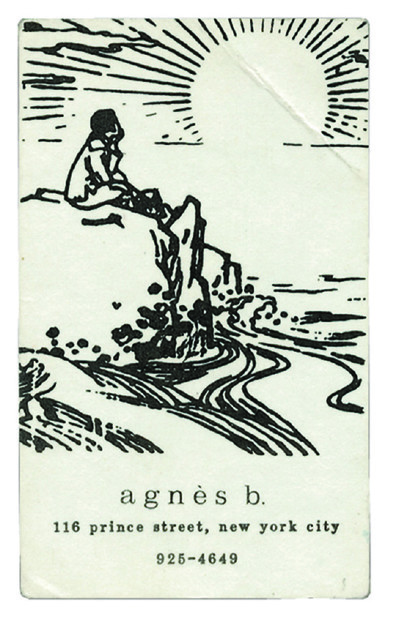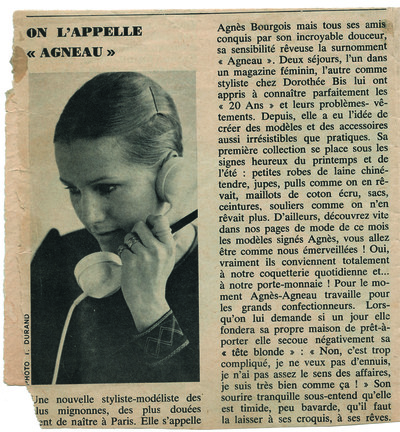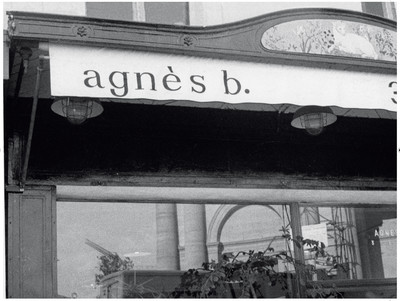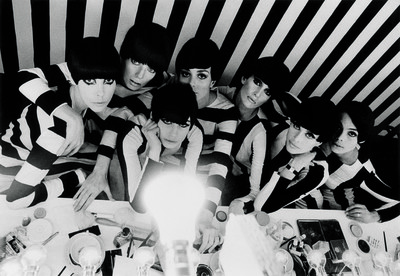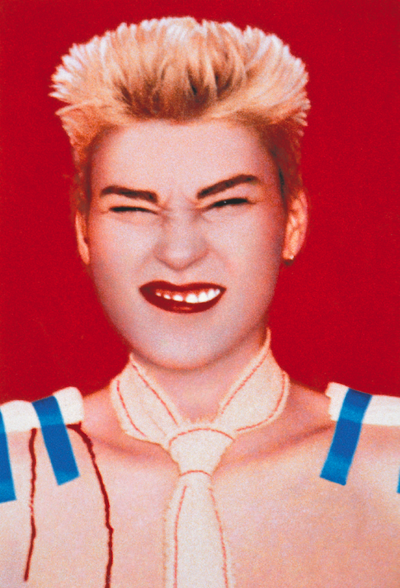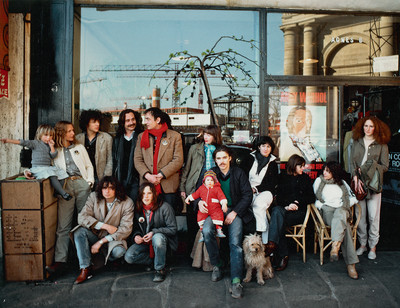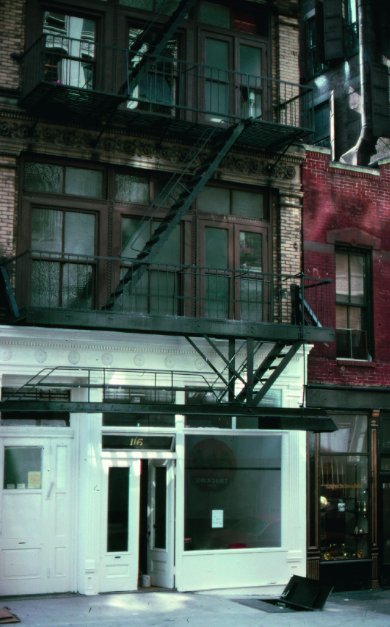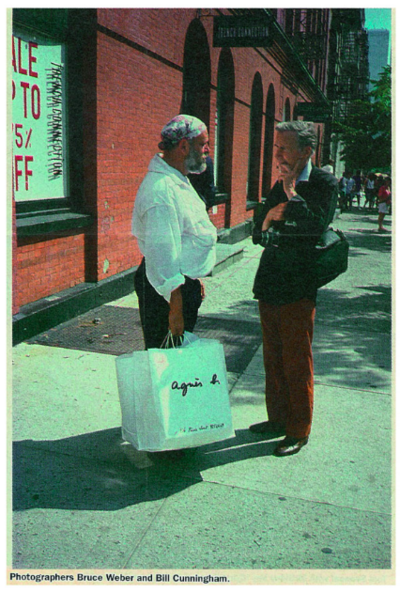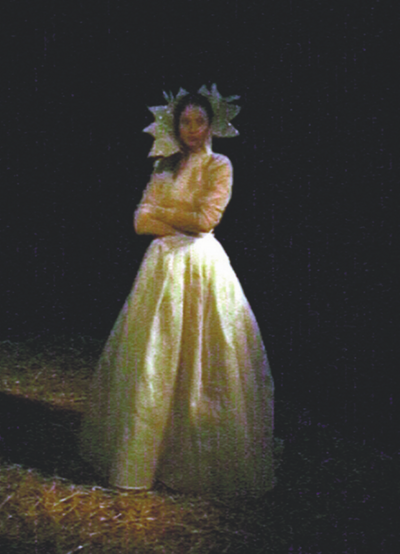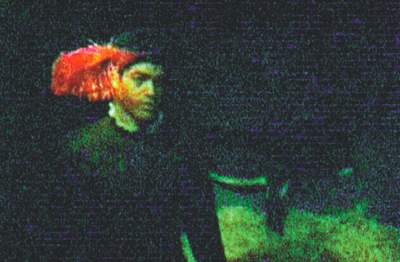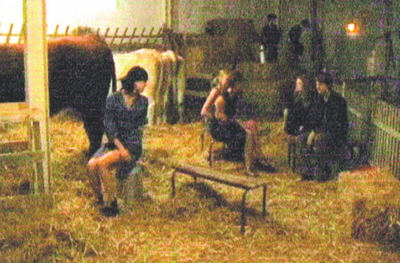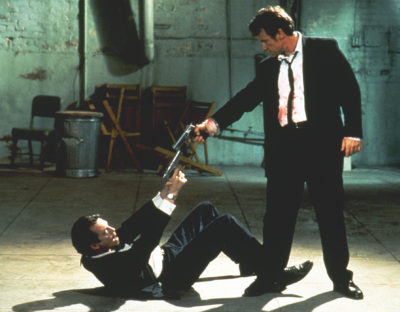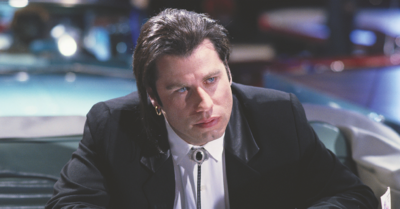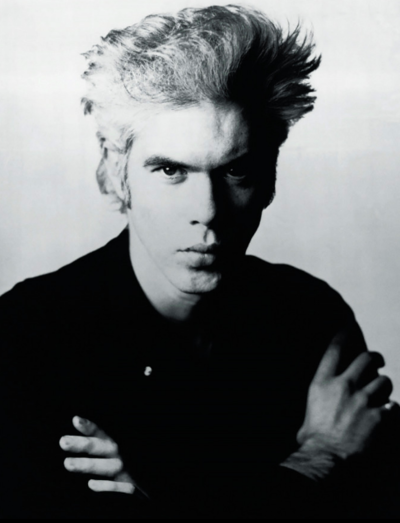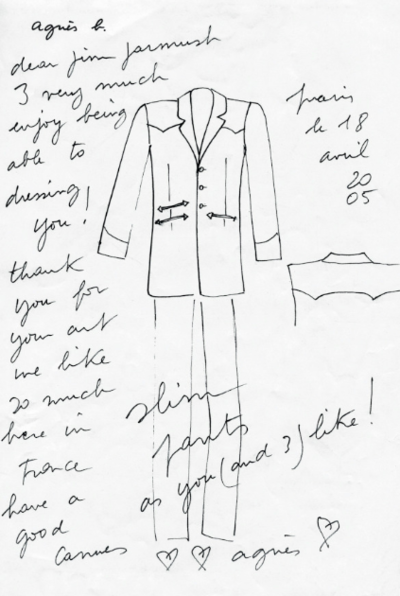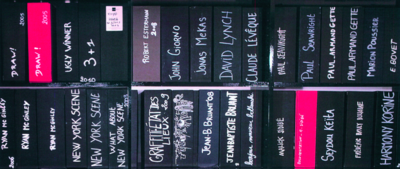Long before the fashion industry co-opted art, there was Agnès B.
By Loïc Prigent
Portraits by Dominique Issermann
Long before the fashion industry co-opted art, there was Agnès B.
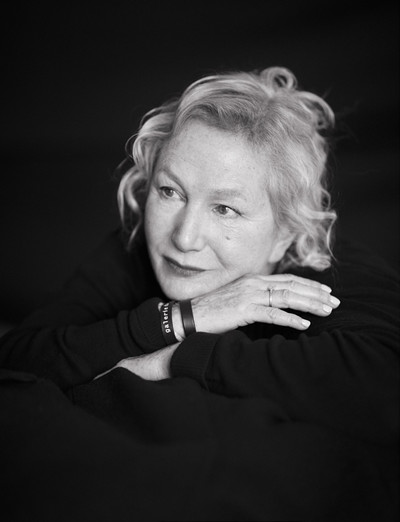
Why Agnès B.? Why now? Simple: she’s a pioneer.
Because if fashion and art, the cultural and the commercial, today seem like such a natural fit, then that is partly thanks to Agnès B.’s vision of how a fashion label should be a central part of a larger cultural matrix; that it is a brand’s duty to use its position to have a wider cultural impact. It is a belief she made real by doing what she does best: following her instincts. So, not for her a multi-million-dollar art foundation or the odd high-profile sponsorship of a blockbuster exhibition. Instead, for over 40 years, she has given continuing (often under-the-radar) support for (often avant-garde) artists whether up-and-coming early masters or once-nearly-forgotten living ones.
Between the art galleries, film-production company, environmental research ship, foundation to coordinate her cultural initiatives, and an ever-increasing art collection, the world of (lower-case) agnès b – the brand – is as far reaching as it is lovingly curated. And she has created it without ever being in hock to the banks or having spent a single centime on advertising. For Agnès B., it’s about doing, not showing (off).
So with the symbiosis between fashion and culture now reaching global ubiquity, it seemed the right moment to reassess Agnès B.’s career and lasting influence. With this in mind, System asked French writer and filmmaker Loïc Prigent to spend an afternoon with the designer at her Parisian apartment near the Louvre. Their free-flowing conversation reveals a designer at odds with fashion’s current imperatives, uncomfortable in the industry, and one, who by being true to her ideas, has created her own community: a professional and social family of artists, filmmakers and kindred spirits.
We then invited three of those people – Jonas Mekas, Ryan McGinley and Harmony Korine – to share their own thoughts on Agnès B., the woman who has in turns been their collaborator, muse, producer, financial backer, facilitator, co-conspirator, and trusted friend.
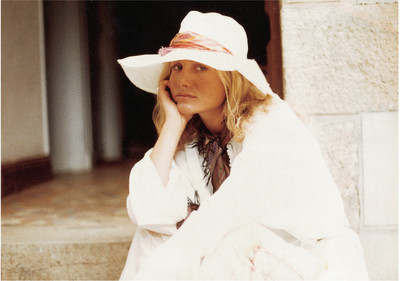
Loïc Prigent: Is your phone often in flight mode?
Agnès B: Well, I put it on at night, of course. I don’t like being woken up at night and I’ve got too many friends who might call me at whatever time.
Loïc: So what did you do today?
Agnès: I had lots of people over at mine last night until very late, so I had to get my head straight this morning… I had quite a few things to think through and organize.
Loïc: What time do you generally wake up?
Agnès: I’m not a morning person at all. I don’t like going to bed; I have to force myself to go to bed, but then I still need eight hours sleep.
Loïc: When you sleep late, it interferes with the start of the day. What time will you go to Rue Dieu today?
Agnès: I’ll go in later, but it doesn’t matter because we’ve done the collection, and they’re doing the buying, so it’s less…
Loïc: …interesting for you.
Agnès: No, it’s not less interesting, it’s just less my job than doing the actual collection.
Loïc: Exactly, it’s less creative.
Agnès: It still interests me because the problem is, and it’s the same in all houses, I’ve always known it, that the sales department always has trouble accepting new ideas and new things. They’re
always looking back at what sold well last year.
Loïc: I saw you at the Macron’s fashion dinner at the Élysée. You said hello to Jean Touitou of APC; that was funny.
Agnès: It was the first time I’d seen him in 30 years.
‘I am very distanced from it all; I don’t often read fashion magazines; I never go out shopping. I only ever wear the clothes that I’ve made.’
Loïc: I love how you leapt on him.
Agnès: I felt totally out of place there. It really wasn’t enjoyable; I didn’t think it was cool at all.
Loïc: Why? I thought it was rather nice.
Agnès: No one came to say hello; it’s crazy!
Loïc: They didn’t come over to say hello to you?
Agnès: It simply isn’t a world that I know. There was Alber Elbaz who came to say hi to me; I think he was the only one though. I was on Jérôme Dreyfuss’s table; he’s very nice. We didn’t know the others though. I think we’re all in a bubble. It depends, maybe it’s different with the younger ones.
Loïc: Inès de la Fressange said the same thing about the fashion dinner in 1984, that there was tension between the designers, but there isn’t any more.
Agnès: You know, I am very distanced from it all; I don’t often read fashion magazines; I never go out shopping. I don’t know about that, I really don’t. I only ever wear what I’ve made. And in fact, I like to protect myself, to not really know what everyone else is doing. I think it’s the street that creates
trends anyway. I never work with any documentation, for example. It’s all instinctive.
Loïc: No moodboard?
Agnès: Not one. Sometimes I put my own photos onto clothes or an engraving from my grandmother’s house or a sculpture. We weave them together; we do lots of things. I’ve been doing photo dresses for a long time now. And it’s funny because they’ve never appeared in a magazine.
Loïc: Does that frustrate you?
Agnès: If you don’t pay for advertising, there’s no point; the press don’t even bother turning up to the show anymore.
Loïc: So it’s officially a give-give situation.
Agnès: You know it is. Are we even allowed to talk about that?
Loïc: Sure we can talk about it.
Agnès: It’s impossible for young designers or someone like me who was carried along by the press because they always knew how to see the new in what I was doing. I started my career at Elle with Hélène Lazareff. With her, there was never question of taking freebies or making any compromises.
Loïc: No freebies at all?
Agnès: Hélène Lazareff was very, very straight. There were no freebies and above all, you had to be absolutely objective so you could see what was new. Now it’s all happening on the Internet anyway, but the odd press cutting every now and then would be nice all the same.
Loïc: I still have the impression you’re always on, or at least keeping an eye on, the Place de la République.
Agnès: I am, among other places. I love the street. I love people and simple things that aren’t a pain to put on… like the costumes I did for William Klein’s film, Polly Maggoo.
Loïc: Was that you who did the famous stripes in the model’s backstage sequence?
Agnès: Yes! I was only 22, 23 years old, working at Dorothée Bis. You can see the outfits in my book. With lots of photos of clothes I took myself.
Loïc: Do you take your own photos because you don’t like delegating?
Agnès: No, it’s just that I love taking photos; it’s such a complete job. Like choosing the person to wear the clothes; I love models who are also friends or who have other jobs altogether. I love amateurism, because it means you love it. Maybe I get too personal, but people expect me to be personal. When they see me picking up the camera to take photos, everyone is happy, because that means it’s going to be simple, quick and easy.
Loïc: I was very surprised at your last runway show, the last one, in March. You took the microphone during the show.
Agnès: I announced the collaboration with Nekfeu, when I was supposed to introduce Laure-Hélène Vaudier, who works for us. Every season I invite a new designer to show, to give them a bit of exposure. We manufacture the clothes for them and then they go into the shops. It’s about helping to launch them and getting their names out there.
Loïc: How does that work? Do you sign off what she does?
Agnès: I said to her, do what you want, be yourself, I have faith in you, take the fabrics you want, work in the atelier, make your pictures. I don’t want to see anything until the day of the show. It’s better that way.
Loïc: Seriously? Why is that better?
Agnès: Because then they are responsible for their own thing and will take it all the way. I want to let them create.
Loïc: So she had 100-percent freedom and how much time to do the collection?
Agnès: At least two months.
Loïc: What motivates you to do that? Is it about passing things on?
Agnès: It’s such a pleasure to give them a chance to show their work. I don’t have a studio, I don’t have people working with me or people who design for me, and I just can’t put my name on a garment that I haven’t personally designed.
Loïc: What? Really?
Agnès: I’ve never done it, that’s just how it is.
Loïc: But everyone does that today, there are like a hundred thousand people working in all the studios…
Agnès: Not me.
Loïc: And as they’ve increased the collections, they have increased the staff.
Agnès: No, not us, we don’t work like that. I simply cannot put my name on something if I didn’t do it. Perhaps that’s something from my childhood, the ethics of Versailles. My education was very much about respect for others, so I will not put my name onto something designed by someone else.
‘We had to quickly find a name, so I said, ‘Oh, you may as well just use Agnès B.’, like in a crime story where they don’t put the full name.’
Loïc: So for the last 42 years there hasn’t been a single thing released that you didn’t design?
Agnès: No, apart from the artists’ T-shirts.
Loïc: Not a season when you were ill or became enamoured with someone in the studio and let them do it?
Agnès: I don’t have a studio, I told you that. There’s the girl who takes care of fabrics, and the one who deals with buttons and zips, a girl in charge of jersey, and another in charge of knits, but I do
everything myself.
Loïc: I’m feeling guilty now about keeping you all afternoon!
Agnès: Now it’s fine; the collection is done. I’ll be getting on with the men’s summer line soon; I’ve already started putting things aside for that. A collection is six months of work and every three months I have a collection, so I’m always at it.
Loïc: Like an industrious ant.
Agnès: In fact, I am always doing two collections at once.
Loïc: And you’ve never had any trouble staying motivated? Finding the energy I hear so many of your colleagues moaning about.
Agnès: Of course it’s tiring. I would like to find someone to replace me afterwards.
Loïc: Like Ann Demeulemeester did?
Agnès: Like I-don’t-know-who. I don’t know Ann Demeulemeester; I don’t know what she does. I’ve never even seen one of her collections. Well, I may have seen pictures, but I don’t know her.
Loïc: You’re really that out of the loop?
Agnès: Believe me, I don’t know anyone in fashion!
Loïc: You’re so completely not part of the fashion scene…
Agnès: Completely! I’m much more involved with the art world. I’m the president of the hip-hop centre in Les Halles; I am passionate about that. I’m the president of the Friends of the
Beaux-Arts. All very different sorts of self-expression. I’m so much more involved in all that, and I’ve had my gallery since 1984. I have lots of artist friends in different places from Japan to New York and LA, and spend much more time with them than any fashion people. I just don’t know them at all, apart from Castelbajac because we started at the same time and he’s someone I really like. I was very fond of Azzedine, too, but I wouldn’t go to his dinners. We’d kiss when we saw each other, because I’d known him for so long.
Loïc: The two outsiders.
Agnès: You know, I didn’t even recognize Isabel Marant when I saw her at the Elysée dinner. I thought she was Mme. Macron’s assistant!
Loïc: Did you get a chance to talk to Mme. Macron?
Agnès: I wanted to talk to her about a law that doesn’t work. At the moment we’re not allowed to work at nights even though that’s what you do at collection time. We used to have dinner and then continue working afterwards. Now we get inspected at peak times, when we have the most work. It’s like Easter eggs – chocolate-makers have a lot more work at Easter! It needs to be understood that our needs change during the year, and people get paid and then given time off later.
Loïc: You like that effervescence!
Agnès: Yes, it’s exciting when we’re together – we listen to music and have fun, and they see me playing dolls with the models. Everything we’ve worked on arrives and I can put it all together,
then think about what shoes, what jewellery, what hat. During those two days before the show I put together the looks, I ask their opinions, that’s how I work, I need their input.
Loïc: Do they ever say no to you?
Agnès: Sometimes, they’ll say, ‘Not really’ and so I’m like, ‘OK, let’s try something else’. It’s a fun time, one we all love.
Loïc: And then since the ‘35 heures’ law you can’t work past what time?
Agnès: They came to inspect six months ago at 8pm, and there were employees still there, and we got fined. Now we have to pay more attention and it’s a lot less fun.
Loïc: Did you get your message over at the Élysée?
Agnès: No, I didn’t. I’ve got other things I need to discuss there, too.
Loïc: Which are?
Agnès: So many things. I saw this thing earlier about restaurants in these tiny villages that no longer have the right to put signs outside the village because it supposedly looks ugly. It’s complete
bullshit, like making retired people pay when there are so many rich people in France who don’t even pay their taxes here! There really is a lot to do. But I am happy with our new president.
‘I was at a party in New York and this stranger, who was Ryan McGinley, came up and showed me these 10 crumpled photos he had in his back pocket.’
Loïc: I get the impression you’re a lot more at ease in the company of artists, people like Ryan McGinley.
Agnès: Yes, possibly. I was at a party in New York and this stranger, who was Ryan, came up to me and just showed me these 10 photos he had in his back pocket. And then that was how I ended up showing them in Los Angeles in a boutique I had on North Robertson Boulevard. There was a wall in there to put things on and where I have always hung art as much as possible. So, I had the photos printed and voilà. Then he went off to some other gallery I don’t know where. But [art dealer and gallery owner] Yvon Lambert always says: ‘You discover them and we do the work afterwards.’ My artists are often shown later in more prestigious galleries – that’s just how it is.
Loïc: You’re the pioneer.
Agnès: Yes, but I love that.
Loïc: Isn’t it frustrating though when they move on?
Agnès: I don’t resent the artists for that, more the gallery owners, who sometimes don’t even bother writing me a letter to tell me. I won’t cite any names…
Loïc: Oh, you can if you like.
Agnès: No I won’t, but it’s happened so many times. The artists think they will be better taken care of, but that isn’t always the case.
Loïc: I suppose prices go up when they go to bigger galleries.
Agnès: Yes, of course they do.
Loïc: Your pricing is something that’s always astonished me. It just doesn’t seem like you’re speculating…
Agnès: No.
Loïc: The prices are comparatively low with you. For Ryan McGinley, I think it was €5,000 maximum when he was at your gallery.
Agnès: It depends; there was more expensive, but there was also cheaper.
Loïc: How do you establish the prices?
Agnès: When we have someone unknown, then we price low, and they are often unknowns to start with. Then later…
Loïc: Like when you were selling [Jacques-Henri] Lartigue recently.
Agnès: I’ve wanted to do a Lartigue show for a long time because I think it’s interesting to know what went on before, especially for young photographers today. I felt it was educational to see how at the start of the 20th century, there was someone doing photographs with these beautiful texts. I think that show was a photography lesson for younger photographers. That freedom, that poetry, that lust for life, I’ve always found it incredibly important to show all that.
Loïc: The exhibition was crazy. There were these monographs that are available in all the biggest museums and there were things that have already been on show, but there were also previously
unseen images, and the prices were pretty reasonable.
Agnès: We established the prices with the Donation Jacques Henri Lartigue.
Loïc: With things actually signed by him. They were new prints from the Avedon period, weren’t they?
Agnès: There was a selection: vintage prints, recent prints, previously unseen images that had never been printed before. They had found negatives and we worked very closely with the Donation Lartigue.
Loïc: The prices weren’t speculative.
Agnès: I don’t do that. I don’t know what it all means. I know what I can pay for work by an unknown artist. Like when I was showing Nan Goldin in 1991. I did her first slide show, we went to the cinema in Bastille and I said, ‘Why don’t we project your photos and you talk out loud about how you feel about each one?’ We were both almost in tears, but wow, it was beautiful. It was the first time she did that. It was just so instinctive, amateur sure, but it pushed me to do other things in a different way. When I say I’m pragmatic, it’s true, but then I am also very instinctive with the artists I communicate with. We have a very delicate dialogue. Very simple. For example, they always talk to me about their childhood, Basquiat included.
Loïc: Where did you meet him?
Agnès: I bought a drawing in his studio in 1983, a stunning self-portrait, which had been pinned up with two drawing pins for years.
Loïc: You bought it at his studio?
Agnès: Yes, because I had seen a canvas at the Paris Biennale in 1982 with his name, and I said to myself, I’d like to meet him. It wasn’t at all expensive; I put the pins through the holes that Basquiat had already made. I didn’t know anyone else in Paris who’d heard of him and since then I have bought other drawings by him, as well as Plastic Sax, a fabulous yellow, blue and turquoise painting. I remember his last show at Yvon’s; it was about six months before he died. ‘So that’s you,’ he
said to me, because he’d bought himself an agnès b. by Warhol T-shirt for his birthday, which I only found out afterwards. It’s funny, he loved agnès b. white shirts. ‘So that’s you,’ he said,
with all his height, his hair, his brown suit and white shirt, black tie, very chic, very beautiful, like in the photo. And I said, ‘Yes, this is me’. Then I left and thought I wouldn’t see him again. But in fact, he was waiting for me in the pizzeria across the road and he called out to me, ‘Agnès! Agnès!’ So I said to myself, ‘Well, I’ll go and see him’ and we ended up talking for two hours instead of going to Castelbajac’s dinner. The next night he called me, wanting me to join him at the Crillon. I said, ‘No, sorry, I can’t’. The next night the same thing, then he trashed his hotel room. Yvon recently told me that he had fallen in love with me. I’d said, ‘I’ll see you in New York, I’ll be coming soon, maybe we’ll see each other then’. I tried to say that to him because he was incredibly seductive, and we’d talked and talked. It really was marvellous; we got on so well. Similar to Harmony Korine, actually.
‘Basquiat wanted me to join him at the Crillon [hotel] that night. I said, ‘No, sorry, I can’t’. I was recently told that he had fallen in love with me.’
Loïc: A love story that never happened. Could you have fallen in love with Basquiat?
Agnès: I could have done, but I had a new lover at the time and I was too complicated. I lived here with four children. It was complicated. I wasn’t just going to rock up to the Crillon at 4am. I wasn’t
in the mood.
Loïc: It wasn’t the right love story at the right time.
Agnès: No, but I was pretty taken aback all the same.
Loïc: Do you often get artists coming up to you, like Ryan McGinley did, with 10 photos stuffed in their pockets?
Agnès: There are some who come and see me like that, yes. Like Claire Tabouret, for example, I knew her at the Beaux-Arts and I loved her work. I’m never disappointed by artists – it’s crazy!
Loïc: And when was the last time you went to the Louvre? You really live just around the corner from it, so do you go often?
Agnès: I went to the Louvre a lot as a child. I was in love with the Man with a Glove by Titian.He’s beautiful, isn’t he? I think I was 10 years old.
Loïc: Are you satisfied with the size of agnès b. today?
Agnès: Gosh, I don’t know. I could easily have stayed in the Rue du Jour doing my own dyeing and selling clothes that hadn’t even dried. That’s how it was at the start, people would leave with dyed
petticoats that were still damp stuffed into plastic bags.
Loïc: It could have stayed something small. When did it start to take off?
Agnès: It was with my daughters’ father, my second husband, and then the Japanese man who came to see us, and the development in Japan in the early 1980s. They adored my stuff and still do – now all the Japanese kids want agnès b. caps. It’s funny how things come around.
Loïc: Is there a big demand for caps?
Agnès: They’re popular because of the b. from agnès b. which makes it look like being a member of a business whose ethics and vision they like. They do buy other things, though. Our original customers are in their 50s now, but agnès b. is still very trendy in Japan, so there’s definitely a revival. I’m really well-known there; they all kiss me and try to grab my hair. It’s crazy over there.
Loïc: Did the company’s growth scare you?
Agnès: I can’t say it was something I was looking for, but because of it, I’ve been able to do lots of other things and I can help lots of people. I can have my foundation and the endowment funds. I
truly believe that the rich have to share their wealth, and I want to say, in a nutshell: the rich should share! What are they going to do with all their money when they’re dead? So many people could live off their taxes if they paid them. But instead they die with all that money. What are they going to do with it? As my grandmother always used to say: ‘Shrouds don’t have pockets.’ I love that expression. Anyway, I believe in art now.
Loïc: So you’ve never worried about losing your soul?
Agnès: No, because I’m doing things my way against all the odds and maybe I’m wrong, but I don’t think so. I really need to find someone as determined as me, but it’ll happen one of these days.
Loïc: Do you have a CEO today?
Agnès: Yes, me. I am designer and CEO. I am the designer at agnès b. and my son is the director, Étienne Bourgois, one of the twins I had with Christian Bourgois. We’re a family maison; we don’t have banks holding us by the purse strings.
Loïc: So you don’t have vast loans?
Agnès: No, no.
Loïc: And you never do advertising campaigns?
Agnès: We have never advertised; I’m completely against advertising; I hate advertising. Advertising is stupid and makes you stupid. May 1968 affected me, but even before, I didn’t like it. I was living with Philippe Michel, the father of my eldest daughter; he was a big ad man, and I think what interested him was everything I said against advertising. It stimulated and attracted him. He saw how I was. I have never done any advertising.
‘We have never advertised; I’m completely against it. Advertising is stupid and makes you stupid. May 1968 affected me, but even before, I didn’t like it.’
Loïc: So the only advertising I can see are your shows themselves?
Agnès: My shows, Instagram, the Internet, but it’s not very well done. I need
to take care of that actually, because I don’t think it looks good.
Loïc: At the shows, why do your models stop in front of the audience?
Agnès: Because we tell them to, so the audience has enough time to have a good look.
Loïc: You’re the only place where that happens.
Agnès: Really?
Loïc: Yours is the only show where I have enough time to actually see the clothes. The others send out a new look every six seconds and then they walk super-fast. And there are no pauses, even at the end of the catwalk.
Agnès: More importantly – I mean, I don’t know but based on the little I see, because literally I never even watch the shows on TV – but I find they’re like robots; they’re all the same. What I want is to show human beings, which isn’t the same job at all.
Loïc: Yes, yours almost seem to saunter.
Agnès: Exactly.
Loïc: But you still respect the rules, they’re just strolling nonchalantly. I’ve filmed you backstage and saw how hands-on you are. There isn’t an army of people endlessly retouching behind you.
Agnès: Absolutely not. I see it as a game; I have fun, and I’m not at all stressed out. I wasn’t stressed, did you notice that? I think there are much more serious things in life. Like when someone close to you is ill.
Loïc: Didn’t you make red scarves in 1988 in the fight against AIDS?
We still make them. We sell them to help people who have AIDS, but don’t have enough for cigarettes or candy. We’ve been doing it forever. As soon as the AIDS epidemic started, I was in the midst of it all, with people who were ill, people who were dying. Between the drugs and AIDS, the 1980s was a slaughter in artistic circles. And straight away I said, ‘OK, we’re going to put jars of condoms in the shops’. It used to cost 10 francs for a condom and I thought that was outrageous. I thought that everyone would do the same, but we’re still the only ones with jars of condoms.
Loïc: For free?
Agnès: Yes, I decided that. I was very close to the organization Act Up. We did agnès b. with Act Up; I did T-shirts for them, too. I was lying on the ground with Pierre Bergé in front of the Louvre; we were all lying on the ground in the rue de Rivoli.
Loïc: Why did Act Up mean so much to you?
Agnès: It still does; I’m very sensitive to pain.
Loïc: And prone to anger?
Agnès: Yes, I can get cross about things, like Sarajevo. Nearly four years in Europe, a whole community besieged in a city in the 20th century – it just knocked me sideways. I said to myself: ‘How do you cope when your child is crying and hungry, and you’ve got nothing to give them – no water, no heating, no food.’ There was this guy who worked for me in the shop, who I really like, and we said we have to do something. So he founded Première Urgence, filled up lorries in the western suburbs of Paris and drove to Sarajevo in the middle of winter.
Loïc: Have you always seen agnès b. as a sort of transmitter?
Agnès: I had a lot of support from the press because Elle, Marie Claire and Jardin des Modes all instantly saw what was happening and that it was quite unlike anything else at the time.
Loïc: To start with, they saw the clothes and then you became more than just clothes.
Agnès: Yes, then came the gallery; then there were the people I was dressing; then there was Pulp Fiction and Reservoir Dogs: Tarantino sent his wardrobe mistress to the shop in LA.
Loïc: Did you sell a lot of suits after Reservoir Dogs?
Agnès: I don’t know, but Harvey Keitel still has his jacket with the bullet holes in. He told me they found it in storage and he wanted me to exhibit it in Paris. I’m great friends with Harvey; I like him a lot.
Loïc: He still has his agnès b. suit with bullet holes in it!
Agnès: Since Reservoir Dogs, he’s kept that jacket, in T051 anthracite grey that doesn’t crease. Everyone loved it because a suit that doesn’t crease is pretty good, for aeroplanes and all that.
‘Harvey Keitel still has his agnès b jacket; the ones they all wore in Reservoir Dogs. He told me they found it in storage and it still has bullet holes in it!’
Loïc: I agree. But tell me, was there a masterplan from the beginning?
Agnès: No, to begin with, I said to myself, I’m going to be peaceful: I’ll spend my days in the shop and I’ll go home at night. The apartment was painted all black, while in the shop there were birds flying around inside.
Loïc: There were really birds inside the shop?
Agnès: We had 35 in the end.
Loïc: So agnès b. was improvised?
Agnès: I wanted to be a museum curator when I was young, then I got married when I was 17, had the twins when I was 19 and left my husband when I was 20.
Loïc: That’s pretty wild.
Agnès: Then I worked at Elle because they’d noticed me. I didn’t have a choice; I had no money at all, no one gave me any money. I had to make things work, so I started selling my drawings. I’d take
my bottles back for the deposit and buy two slices of ham or a tin of tuna to feed the children in the evenings. We would have a chicken every three weeks; we weren’t unhappy though. Then May
1968 happened and I was obviously in the streets. I was with my twins and my parents were saying, ‘We don’t want you to stay in Paris’, but I was like, ‘Yeah, yeah, but I’m having a great time. We’re
having fun; it’s great’.
Loïc: And the brand was started in…
Agnès: Nineteen seventy-six. It was unisex to begin with, workwear, anonymously designed clothes, and that’s what I loved about them. I’ve always been against the idea of consumerism, so I make clothes that can be worn for 20 years and never go out of fashion.
Loïc: Clothes that aren’t superfluous.
Agnès: Nothing superfluous that can go out of fashion. You can wear them for a very long time. This thing I’m wearing now, I’ve had it for at least 15 years.
Loïc: The idea being to enjoy life itself more than the clothes.
Agnès: I do things instinctively, that’s how I work. Also, I like people and I want to make them happy. That’s the gift for me – giving other people pleasure so they’re happy with what they have. Lots of customers stop me in the street and tell me stories about their clothes. It’s really touching because a piece of clothing can be like a talisman, something that reminds you of a happy memory. A piece of clothing can mean so many things.
Loïc: Has there ever been a time when you have felt less sincere in your work or has it always been like that?
Agnès: I have always been the same.
Loïc: So you set up the label in 1976…
Agnès: And we had to find a name, because when Elle first featured my
clothes, I was at my father’s office, which was at my grandmother’s, and the magazine asked what name to put for the credit. So I said, ‘Oh, you may as well just use Agnès B.’, like in a crime story where they don’t put the full name. I didn’t want to use Bourgois, he was a publisher, and I wasn’t going to use [my maiden name] Agnès Troublé, so I saidjust use Agnès, B, full stop, and that’s
how it happened.
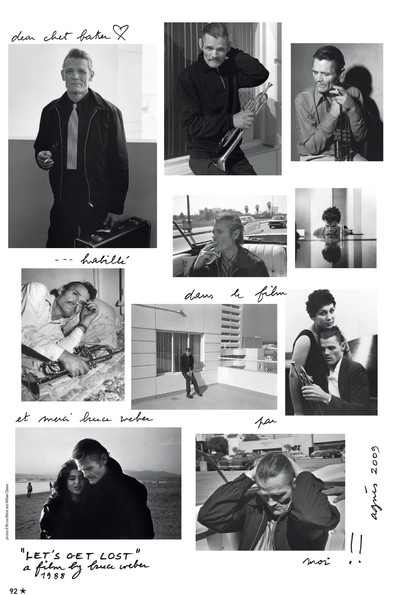
Loïc: Troublé is a lovely name though.
Agnès: Troublé? No, and I didn’t want to take Christian’s name, and my father was a lawyer, president of the bar. I like that agnès b. just came out like that. I love ideas that come out of nowhere like butterflies. You have to catch ideas, watch out for them, and they come.
Loïc: Why did you launch the free publication, le point d’ironie?
Agnès: When I got married my father offered me a rug from the Caucasus and the Larousse du XXe
siècle [encyclopedia] because he’d always seen me reading the Larousse on the rugs at home
when I was a kid, aged 8, 9 and 10. I was always reading the Larousse and so he gave me that as a wedding present, when I was 17. And then 20 years ago, I wanted to do an exhibition about irony in art, the irony in artistic creation. I thought it was very interesting, so I looked up irony in my Larousse and what do I see? The irony punctuation mark. And I thought it was beautiful, I didn’t know it existed, like a back-to-front question mark. And so that was why we called it le point d’ironie, and then we didn’t need to trademark the name because it’s in the public domain, even if no one ever remembers about the irony punctuation mark. I just loved the idea of it – instead of having a smiley, we have
the irony punctuation mark. My dream would be for it to become…
Loïc: An emoji?
Agnès: Yes! We haven’t taken care of it; I don’t know who to ask. I wouldn’t know where to start with that…
Loïc: Tell me about David Bowie. How did you meet?
Agnès: It was me. I love live music and I went to see him at Bercy and it was his Berlin period when he wore a brown suit with pleats.35 I gave him a pair of jeans with a note in the pocket, saying, ‘You should stick to rock’n’roll style’.
‘I saw Bowie during his Berlin period, wearing a pleated brown suit. I gave him a pair of jeans with a note, saying, ‘You should stick to rock’n’roll style.’’
Loïc: No, really? Like a little put-down or wake-up call.
Agnès: Yes, and I think he liked it because he later went and bought four pairs of leather jeans at the agnès b. shop in London and asked me to dress him.
Loïc: You gave him a pair of leather jeans?
Agnès: Yes, a pair of agnès b. black leather jeans; I’ve been making them forever.
Loïc: So has all the money from your clothing label gone into the contemporary-art foundation?
Agnès: I don’t know. There are also the charities we support, and Tara, the ship. She is my contribution to ecology, and has been doing oceanographic research for the past 12 years. It’s the
ship I bought with Étienne; it was Sir Peter Blake’s, the one he was killed on. I bought it from Lady Pippa Blake to continue his oceanographic research. I think we give €600,000 to fund the ship; it’s my contribution to ecology. That’s why I always say the rich should share, because I am certainly a lot less rich than others.
Loïc: How do you build your art collection? Do you do it by yourself?
Agnès: There is someone who manages it, but I buy the works myself from auctions, and galleries and dealers I’m friends with. Like I did with my Warhols. Sometimes I go to artists’ studios directly, and people come and see me, too. There are lots of ways, and there’s also the Beaux-Arts.
Loïc: Do you know the first names of everyone who works for you or are there too many people?
Agnès: Of course I do! There are 135 of us; we’re like a Breton village, like Hœdic, we’re the same number as the residents of the isle of Hœdic.
Loïc: Really? Yes, you’re right, they must all know each other on Hœdic.
Agnès: Everyone knows each other on Hœdic, especially during winter; in summer there are 3,000 people, but in winter, only 135.
Loïc: Have they adopted you?
Agnès: They asked me to be Hœdicaise and I said yes.
Loïc: How long before they asked you?
Agnès: Oh, it was very quick.
Loïc: When did you start going there?
Agnès: Twenty years ago. We were in Brittany and went to the island on a day trip in a sailing boat. Then I went to the town hall and asked if there were ever any houses for sale there. And the woman there said, ‘Yes, my parents’ house is for sale’, and she gave me the key and told me where it was and told me to go visit. So I did and by 3pm, I’d agreed to buy it. It’s a small village house between two other houses.
Loïc: I’m sure that wasn’t very Hœdic of you. Surely you should have thought longer than that.
Agnès: Yes, but it was super. It was completely brown, the doors were brown, the shutters were brown.
Loïc: Did you get Peter Marino to come and redecorate?
Agnès: Of course not! We just painted the shutters blue, the house white, and we called it Lis de Mer, and I made a little lis de mer from shells on the facade. When I go there, once I’m on the boat, I say to myself, ‘That’s it’, and it’s like I drop anchor. We have so much fun. I have some very good friends there too. The people who run the bar, the fishermen; we’ve had friends there, ever since I’ve been going. When I first went there, there was a wedding and I started laughing and dancing, and I made friends with the shopkeeper, and I am still great friends with her; I like her very much.
Loïc: So you’re more at ease with them than you were with the fashion people at the Élysée?
Agnès: Yes absolutely. I just didn’t find the Élysée very friendly; I saw everyone pushing each other for the photos.
Loïc: I thought that was funny. I was sitting next to Stella McCartney; she was in a great mood and very, very funny.
Agnès: I would have liked to meet her. But no one introduced anyone to anyone.
Loïc: What time is it?
Agnès: I don’t know.
Loïc: You don’t know what the time is? Don’t you have to work? Actually, I don’t know what time it is either.
Agnès: I don’t have a watch. I’ve never worn a watch, I don’t like them. I don’t even have my phone with me.
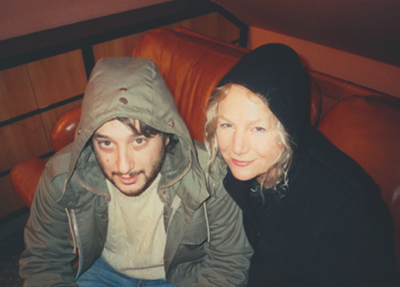
Agnès once picked me up in Paris in a Cadillac. She had to vote, but didn’t like who she had to vote for and I remember her lighting her ballot on fire. That was pretty funny. She was wearing fingerless mittens and smoking a cigarette. Agnès lives life in a very poetic way. She invented her own world, and she’s a radical, a free spirit, and a collaborator. She came to me a couple of years after I started out, and has supported my movies and my artwork. When I was living a bit of a crazy life, Agnès was one of the people who helped me get things back together. I’ve always just thought of her as a great friend. She’s one of my favourite people in the world, and in her own way, a real visionary. Agnès collects the works that she really loves and shows the artists she loves at the gallery; she collaborates with them on the clothes and other projects. She has helped finance movies that I’ve made in the past, and we’ve done books together. I always like to include her and try to get her opinions on things; it’s very free-flowing. Hers is a countercultural pursuit. Even though she has a huge company and is responsible for everything, she’s not corporate, just the opposite. It’s about a style and a life as opposed to anything else. There is nobody like her. What’s fun is that she’s not really making distinctions between high culture and low culture, but simply gravitating towards the things that excite her: from the street up to the palace. And she knows everything! She has affected a lot of people’s lives. She’s an ass-kicker, and someone who lives her life with a great sense of style and passion. I think she knows how much I love her!
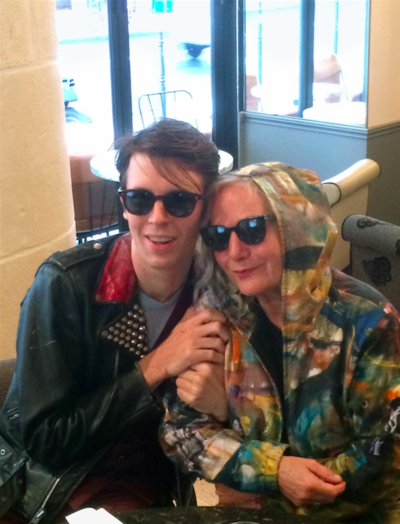
I first met Agnès when she invited me to her hotel-room party in SoHo, after she’d been given my first little book. When I arrived, it was filled with her friends, some from New York and many from Paris. People were drinking Champagne, smoking spliffs, standing on chairs and reading poetry. I was the youngest person in the room but immediately felt at home with my new French crew. She bought a lot of my photos from that first body of work, which helped me get on my feet as an artist. I was able to move out of my small East Village apartment and rent a loft in Chinatown as my art studio. My first exhibition in Paris was at her galerie du jour. I never travelled much as a kid because my family couldn’t afford it, so it was my first time ever being in France. And when I wanted to do my first road trip, but needed a large budget to take photos for two months across the USA, Agnès was there. I proposed the idea that she fund it in exchange for me showing the work at her gallery. I hoped that collectors would buy the work and I could pay her back. She believed in me and the money was soon deposited in my bank account. A few months later, we hung my show at her space and I was able to pay her back what she had invested in me. She was the first person to treat me with respect, kind of celebrate me like a rock star, and show me the good life. She saw what I was doing in the streets of Manhattan should be held in high regard, and definitely helped boost my confidence and self-esteem as an artist. Ultimately, she’s loyal to the artists she loves; she’s like our cool older sister or surrogate mother.
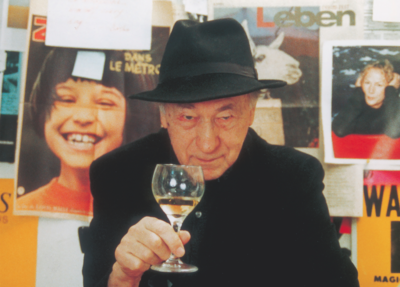
Whenever I am asked to go to Paris, for whatever reason, I always say yes. Not for the reasons given to me, but because I immediately see Agnès’s shining face. Agnès is always happy. Agnès has transcended the sadness of this world. Happiness is contagious, and we need more of it, especially today. I first met her in 1996 on the day the American Center in Paris closed. I was supposed to have a show there, but as it had closed, Agnès just said, ‘Why don’t you come and show at the galerie du jour?’ That’s how we began working together. That’s also when Paris became my second home. No artist could be luckier. Because when Agnès does something, she puts herself completely into it, she puts her heart into it. I have to tell you another wonderful thing about Agnès. She is the youngest of my friends because she is eternally young. And that’s also why she is attractive; she is always surrounded by young people. And countless young artists have received their first shows at Agnès’ gallery. Like them, I am very lucky that she came to my aid when I needed it, with her support, with her shining and love. I am very, very blessed to know Agnès and be her friend. Agnès is my Paris!
